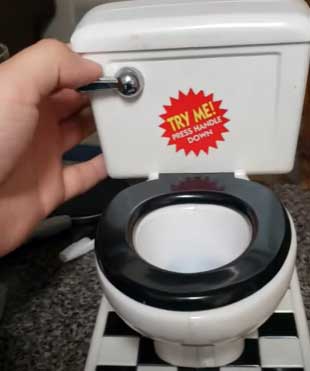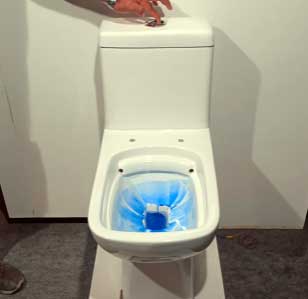Hey there! Flushing a toilet might seem like the simplest thing in the world, right?
You just press the lever, and it’s done. But have you ever stopped to think if you’re doing it correctly? Believe it or not, there’s a proper way to flush a toilet that ensures cleanliness, efficiency, and a well-maintained bathroom.
Let’s dive into the nitty-gritty of flushing the right way, so you can keep your toilet in top-notch shape and maybe even save a bit on your water bill!
Why Flushing Properly Matters?
Before we get into the how, let’s talk about the why. Flushing correctly isn’t just about clearing the bowl; it’s about maintaining hygiene, preventing clogs, and conserving water.
When you do it right, you reduce the risk of bacteria spreading in your bathroom, ensure your plumbing works smoothly, and help the environment by using water efficiently. Plus, who doesn’t want to avoid the dreaded toilet overflow situation?
The Basics Of Flushing A Toilet
Alright, let’s start with the basics. Here’s a step-by-step guide to flushing your toilet properly:

- Check the Bowl: Make sure there’s nothing in the toilet that shouldn’t be there. Kids’ toys, excess toilet paper, or anything that can cause a clog should be removed before you flush.
- Use the Right Amount of Toilet Paper: Overloading the toilet with too much toilet paper can lead to clogs. Use only what you need. A couple of squares usually do the trick.
- Close the Lid: This might surprise you, but closing the lid before you flush is crucial. It helps contain the spray of water and bacteria that occurs during a flush. Trust me, you don’t want those germs spreading around your bathroom!
- Press the Lever or Button Firmly: Different toilets have different mechanisms. Whether you have a lever or a button, make sure you press it firmly and hold it down for a second or two to ensure a full flush.
- Check for Complete Flush: After flushing, make sure everything is gone from the bowl. If not, you might need a second flush. Some modern toilets have dual-flush options, one for liquids and one for solids, which can help with this.
The Science Behind Flushing
Understanding the science of flushing can make you appreciate why these steps are important. When you flush, water from the tank flows into the bowl, creating a siphon effect that pulls the contents down the drain.
The pressure and amount of water are critical for this process.
Modern toilets are designed to use less water while maintaining effective flushing power. However, they require proper usage to function efficiently.
Using too much toilet paper or not pressing the flush lever correctly can disrupt this balance, leading to clogs or incomplete flushes.
Common Mistakes And How To Avoid Them
We all make mistakes, but when it comes to flushing, some common errors can cause big problems. Here’s what to watch out for:
- Overloading the Toilet
Using too much toilet paper or flushing items that shouldn’t be flushed (like wipes, sanitary products, or cotton balls) can lead to blockages. Stick to toilet paper and human waste only.
- Not Holding the Flush
A quick press might not be enough for a complete flush. Hold the lever or button for a couple of seconds to ensure all the water and waste are cleared from the bowl.
- Ignoring the Flush
Sometimes, the toilet might not flush completely due to a weak flush or a partial blockage. Always check that the flush has worked properly and repeat if necessary.
- Skipping Regular Maintenance
Like any other part of your home, your toilet needs regular maintenance. Check for leaks, ensure the flush mechanism is working smoothly, and clean the bowl and tank regularly.
The Eco-Friendly Way To Flush
Being mindful of how you flush can also have environmental benefits. Modern toilets are designed to conserve water, but your habits play a big role too. Here’s how you can make your flushing routine more eco-friendly:
- Use Dual-Flush Toilets

If you have a dual-flush toilet, use the appropriate flush for liquids and solids.
The half-flush option uses significantly less water for liquid waste.
- Fix Leaks Promptly
A leaking toilet can waste a lot of water over time.
If you hear your toilet running continuously, it’s time to check for leaks and fix them.
- Consider a Water-Saving Device
There are devices available that can be installed in your toilet tank to reduce the amount of water used per flush. These are great for older toilets that aren’t as water-efficient.
- Educate Your Household
Make sure everyone in your home knows the proper way to flush. This not only keeps your bathroom cleaner but also helps conserve water.
The Hygiene Aspect
Proper flushing is essential for bathroom hygiene. When you flush with the lid open, tiny droplets of water mixed with waste can become airborne.
This phenomenon, known as “toilet plume,” can spread bacteria and viruses around your bathroom. By closing the lid before flushing, you minimize this risk, keeping your bathroom cleaner and healthier.
- Clean Your Toilet Regularly
Regular cleaning is a must. Use a good toilet cleaner and brush to scrub the bowl at least once a week. Don’t forget to clean under the rim, where bacteria can build up. For the tank, a gentle cleaner and occasional inspection will prevent mold and mineral buildup.
- Wash Your Hands
After flushing, always wash your hands thoroughly with soap and water. This step is crucial for preventing the spread of germs.
Troubleshooting Common Issues
Even with the best practices, you might encounter some flushing issues. Here’s how to handle common problems:
- Weak Flush
If your toilet isn’t flushing strongly enough, check the water level in the tank. It should be about an inch below the top of the overflow tube. If it’s too low, adjust the float. You might also need to clean out mineral deposits in the rim holes or siphon jet.
- Constantly Running Toilet
A toilet that runs continuously can waste a lot of water. This is usually due to a faulty flapper or fill valve. Check the flapper for wear and replace it if necessary. If the fill valve is the issue, it might need cleaning or replacing.
- Clogged Toilet
For minor clogs, a plunger is your best friend. Make sure you have a good seal and use steady, forceful plunges. For more stubborn clogs, a toilet auger might be necessary. If all else fails, calling a plumber is your best bet.
Final Thoughts on Flushing
So, there you have it—the ins and outs of proper toilet flushing.
By paying attention to how you flush, using the right amount of toilet paper, and maintaining your toilet regularly, you can keep your bathroom cleaner, your plumbing in good shape, and even do your part for the environment.
Remember, a little mindfulness goes a long way, and your toilet will thank you for it!
Next time you head to the bathroom, take a moment to think about your flush. It’s a small action, but when done right, it makes a big difference. Happy flushing!
